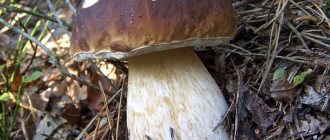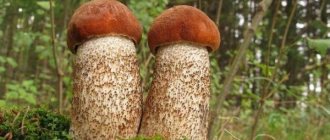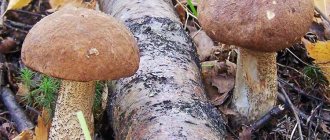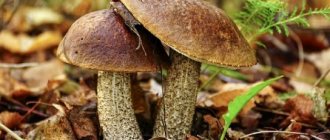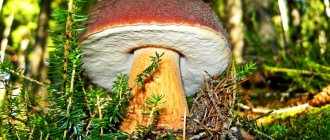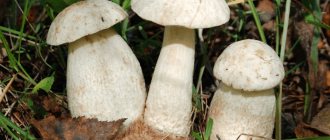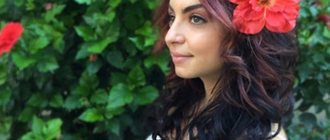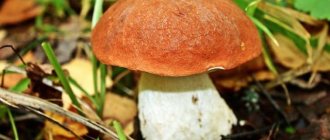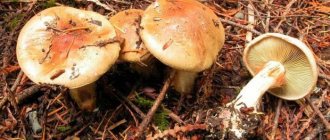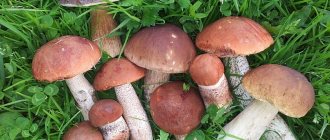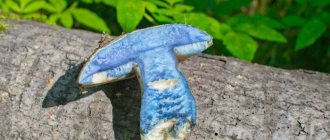And although the cap of this mushroom is bright orange, “hunting” it is not the easiest task. Even experienced mushroom pickers call this forest dweller the mushroom of good luck. Can't guess which one we're talking about? This is a boletus. A basket of these red-hatted beauties is valued almost as much as porcini mushrooms, and they also have more than enough beneficial properties.
Why “boletus”?
The scientific name of this mushroom is Leccinum aurantiacum. But in everyday life it is known as the aspen boletus, since attentive lovers of “quiet hunting” have noticed: more often than not, this beauty is found under aspen trees. Although you should not be surprised if you are lucky enough to find it under spruce, pine, birch, oak, in coniferous-deciduous forests and even on the edges or clearings in groups or alone. True, there are representatives of some varieties that differ from their “brothers” from under the aspens.
Content:
- Why “boletus”?
- Varieties of boletus
- Classification by type
- Seasonal classification
- False boletus
- Beneficial features
- Medicinal properties
- Cautions
- Use in the kitchen
- How to grow in the garden
This type of mushroom is common in Eurasia and North America, in temperate forests. Found in shady thickets, on moist soil. These beauties love to hide among blueberries, ferns, mosses and grass, although sometimes their bright caps are visible along forest paths.
The classic boletus is a mushroom that resembles a boletus, but with an orange-red cap (up to 20 cm in diameter), a stocky stem and dense flesh. It reaches its largest dimensions on the 10th day of growth, some specimens grow up to 2 kg. A distinctive feature of a young mushroom is a hemispherical cap, the edges of which are pressed tightly against the stem. The skin on the cap is not sticky, like butterfish, but dry, in some it is velvety. The club-shaped leg in adult boletuses reaches 22 cm. It is easily recognized by its small black or brown scales. The “hunt” for boletus lasts from the beginning of summer until October.
Because of its bright cap, in the old days it was called by many other names: red mushroom, redhead, krasnik, obabok, chelish. Some suggest that the mushroom got its name also because the color of the cap resembles the bright autumn leaves of aspen.
Why is boletus called this?
As for the reason why this name was assigned to the mushroom, it is quite obvious, because it can be extracted even from the name itself. Mushrooms of this type are most often found next to birch trees, under its base. This is a completely rational and very simple explanation of the origin of the name.
By the way, among the names of mushrooms known to us today, there are other very simple and understandable names, for example, it is very easy to answer the question of why not only boletus, but also boletus is called that. After all, boletuses can be found near the bases of aspen trees.
Varieties of boletus
And now - about the varieties. As already mentioned, science knows several species of Leccinum aurantiacum. Some of them are edible, and some can cause serious harm to humans. Although the latter are, of course, no longer real boletuses, but their false doubles.
The first sign of boletus is a red-orange cap and a white leg with dark scales, like a boletus. But it is not uncommon to see white boletuses, which are found in spruce forests, and yellow-brown ones, the “residents” of mixed plantings. White and pink boletuses grow on the damp soils of the forests, and gray ones grow under the poplars.
Another ability of boletuses is to change the color of the stem when cut. The initially white flesh, after damage, changes color to pink, then dark blue or black. And this shouldn't be scary. The fact is that the mushroom contains components that oxidize upon contact with air and enzymes. But such a reaction does not in any way affect the nutritional characteristics and taste.
Still have doubts about the edibility of the mushroom? It's time to look under the hat.
All representatives of the boletaceae family (including aspen boletuses) have a thick porous layer (up to 3 cm) under the cap. As a rule, it is light in color: white, with a yellow-brown or gray tint.
What do boletus and boletus look like?
Boletus is a species of edible mushroom in the Boletaceae family. Its cap grows up to 15 cm in diameter and can vary in color from white-gray to dark brown. The shape at the beginning of growth is hemispherical; as it progresses, the cap becomes pillow-like and has a thin felt surface. In rainy weather it becomes slimy. The boletus pulp is white or pinkish in color, with a pleasant mushroom aroma and taste. In adult specimens it becomes watery and spongy.
The mushroom has a stalk about 15 cm long and up to 3 cm thick. It has the shape of a cylinder, widened at the bottom and thinner near the cap. The color is light gray, the surface is covered with dark longitudinal scales. In adult fruiting bodies it becomes rigid and the fibers become woody. The bottom layer of the cap is initially white, but becomes dark gray with age. Long, sometimes united tubes are easily separated from the cap. The spore powder has a brown-olive tint.
Boletus is an edible species of mushrooms of the Obabok genus. The cap of young fruiting bodies is shaped like a thimble placed on a finger. As it grows, it takes on the shape of a pillow with a velvety surface, and in more mature mushrooms it becomes flat. The colors of the cap are bright: orange, red, brown. Its diameter reaches 20 cm (rarely - 30 cm). The flesh of the mushroom is white and has a dense consistency. The difference between boletus is that when broken, its flesh turns blue, gradually becoming black.
The cylindrical leg is 15–20 cm long and about 5 cm thick. At the bottom it is thinner and greenish, while the main part is white. It goes deep into the ground. The surface is velvety to the touch, with longitudinal, fibrous brown scales.
Classification by type
At first glance, it may seem that all boletuses are similar. But experienced mushroom pickers know that this is not so. And different species have their own distinctive features.
Red boletus
This edible mushroom is found under deciduous trees: aspens, birches, beeches, poplars, willows, and oaks. It is small - up to 15 cm in height and with a cap about 10 cm in diameter. The caps of these representatives are bright red or red-brown, the scales on the stem are gray-white. It grows in Europe, Siberia, the Far East and the Caucasus, in the tundra it is found under dwarf birch trees.
Yellow-brown boletus
Other names are red-brown or multi-skinned obabok. A fairly large representative of forests - it can reach 25 cm in height, with a cap diameter of up to 15 cm. The caps are yellow-brown or sandy-orange in color, the legs are usually gray with frequent granular scales of brown-black color. This species is common in temperate forests. Myceliums are found near birch, aspen, and pine and spruce-birch forests.
White boletus
A distinctive feature of young mushrooms is a white cap, which, however, with age reaches 25 cm in diameter and darkens to a gray-brown color. The leg is white, with the same scales. Few people are lucky enough to find such a mushroom. If desired, you should look for it on the moist soils of spruce-birch forests, under aspen trees. Geographically distributed in North America, Western Europe, Siberia, the Baltic countries, and some regions of Russia.
Oak redhead
It resembles boletus mushrooms more than other varieties. Grows in the shade of oak trees. It can be recognized by its coffee-brown cap with orange tints and a stem covered with reddish-brown scales. These mushrooms are quite common in the northern hemisphere - in temperate forests.
Boletus with painted legs
This representative resembles ordinary boletuses less than others. Its cap is often flat and pink in color, uncharacteristic for redheads. The leg is covered with the same scales (or red). Distributed in the eastern regions of North America and Asia, in deciduous and coniferous forests.
Redhead pine
This is an edible mushroom with a dark crimson cap and a stem covered with brown scales. Its height and cap diameter rarely exceed 15 cm. It should be “hunted” in the humid spruce and pine forests of Europe. Experienced mushroom pickers advise, first of all, to carefully examine the base of pine trees and thickets of bearberry - this is where the redhead hides most often.
Black-scaled boletus
It is not difficult to recognize this mushroom. Its cap is brick, dark red or orange, and its leg is dotted with reddish scales. Distinctive feature: the white leg quickly turns purple or gray-black after damage.
Spruce redhead
A small representative of the boletus family with a chestnut cap and a cylindrical stem with light brown scales. Rarely found alone. Mycelium grows in all coniferous forests, but best under spruce trees. Sometimes found in mixed forests.
Boletus habitats
Boletuses are the most common type of mushroom. They mainly grow in temperate latitudes of North America and Eurasia. These mushrooms choose a partner tree, which can be not only aspen. A large number of them can be collected in pine, mixed and deciduous forests.
Unlike other mushrooms, boletus grows not only next to old trees, but also next to young ones. It happens that the summer is hot and dry, there are few other mushrooms, and redhead can easily be found in moist, shady aspen thickets. Boletus is one of the fastest growing mushrooms, and spreads quite quickly over large areas.
Seasonal classification
The fruiting season for boletuses is very long. And the summer representatives are somewhat different from their October “brothers”.
People noticed these features a long time ago, which is why they divided mushrooms into three seasonal groups.
Kolosoviki are boletuses that appear at the end of June and disappear at the end of the first ten days of July. These are the very first mushrooms, of which there are usually few. During the indicated period, yellow-brown and white boletuses are found.
Reapers - appear in mid-July and bear fruit until the end of August - beginning of September. This is the “star” time of red boletuses, oak boletuses, and black-scaled boletuses.
Deciduous mushrooms are the last mushrooms to appear in the second half of September. Until the first frost, you can “hunt” for redheads in pine and spruce forests with rich coniferous litter, which protects the mushrooms from the cold.
Interesting facts about boletus
There are many interesting facts associated with red-headed mushrooms. Some of them are widely known, others are known only to experienced mushroom pickers:
- Aspen, or redhead, is a unique mushroom that has no poisonous counterparts. It is especially recommended for novice mushroom pickers to collect it, since the photo of the red boletus is so recognizable that it simply cannot be confused with a toxic variety. It is rarely mistakenly mistaken only for a gall fungus, but even that does not harm health, but is simply unsuitable for food due to its bitter taste.
- The pulp of the redhead contains a huge amount of valuable substances. Eating it is not only tasty, but also healthy. The high protein content in mushroom pulp deserves special mention - dishes made from aspen mushrooms are in no way inferior in nutritional value to meat dishes.
You can find boletuses in the forests throughout the warm season. There is even a special folk classification of mushrooms according to the timing of fruiting.
For example, yellow-brown and white aspen trees are called spikelets, since they are found mainly in early summer. Oak and black-scaled mushrooms appear en masse in July-August and are therefore called stubble mushrooms. But ordinary redheads are called deciduous ones, since they are found in forests from the beginning of September until frost.
False boletus
In addition to the fact that boletuses are one of the most beautiful, tasty and healthy mushrooms, they are also one of the safest forest gifts.
Despite the impressive number of varieties, these mushrooms are practically never poisonous. But novice mushroom pickers still often wonder what a false aspen boletus looks like. However, more experienced ones assure: there are no false redheads in nature. The only problem is that, due to inexperience, some people mistake bitterling (gall mushroom) for boletus. You can identify “false boletus” by the characteristic brown mesh on the stem (instead of scales), pink or brown spots on the cut, and a bitter taste.
text-reasoning about the names of the mushrooms boletus boletus.
The boletus mushroom grows in deciduous forests, mainly in birch forests.
Mushrooms are found in parks and young growths of birch trees near forests; they love the edges of clearings, overgrown old paths in light mixed forests and along the edges of ravines. The boletus appears at the end of May at the same time as boletus and white boletus, or a little earlier. The boletus loves warmth and grows where the sun warms up the soil with mycelium well. The boletus has four varieties: • Common • Black • Swamp or white • Pinkish The most valuable is the common boletus, it is found most often and has the best taste among its relatives. The common boletus has a cap up to 15 cm in diameter, light brown (for young ones) and dark brown (for mature ones). The pulp is white, dense, and does not change color. Found in birch forests, on the edges of clearings, and in young birch trees. The common boletus has all the advantages of an edible mushroom: it has a pleasant smell and excellent taste. Very good for frying, suitable for drying and pickling. Do you know why aspen boletus is called that?
In the forest, a red cap of a mushroom peeks out from under old fallen aspen leaves. This is an aspen boletus. And a little further away, under that birch tree, a brown boletus cap sticks out. I carefully tear apart the fallen leaves. Yes, there is a whole family of boletus mushrooms: two, three, four... One is smaller than the other. In order not to spoil the cap of the mushroom, I take hold of the bottom of the stem. The root of the mushroom sits tightly in the ground. I quietly remove the top layer of soil and see: thin white mycelium threads go from the root into the ground in different directions. These threads are so intertwined with each other that it is difficult to keep track of where they go next.
It turns out that my entire family of boletus mushrooms is connected to each other underground by these white threads, and all these baby boletus mushrooms are siblings, growing from the same ball of threads, from the same mycelium. The threads of the mycelium, making their way in the ground between the roots of flowers and trees, absorb water and food along the way. Their food is fallen old leaves and last year's rotting grass. Threads water and feed the leg and cap of the mushroom. But what is it?
Individual threads of mycelium come very close to the living roots of birch. They entwine the roots from all sides, they penetrate into the very root. The food they get from the old rotting remains of plants is not enough for them, and they extract sap from living trees by sucking on their roots.
But the tree itself does not lose from this proximity: the threads of the fungus serve as additional roots for it and feed it in turn. The threads of the boletus are “friends” most often with the roots of the birch, the boletus is “friends” with the aspen, the camelina is with the Christmas tree, and so on; That is why each mushroom is found mostly around one specific tree.
There were no boletus in Sweden. And when larch was transplanted there, new mushrooms for Sweden appeared in these new forests - larch boletus.
I recommend you a new interesting video that can be very useful in your hobbies!
Beneficial features
Mushrooms are called vegetarian meat.
And all because this type of product, and boletus is no exception, contains extremely rich reserves of proteins. It is interesting that the human body absorbs proteins from boletus almost completely – 80%. Therefore, this mushroom is an unrivaled source of amino acids and other nutrients important for the restoration of weakened organisms.
Boletus is a good source of fiber, carbohydrates and healthy fats. They contain vitamins A, B, group B, as well as impressive reserves of iron, potassium, magnesium, calcium, phosphorus, and sodium. Interestingly, boletus contains B vitamins in almost the same quantities as cereals, and the reserves of vitamin B3 (nicotinic acid) are similar to the concentration in yeast or liver. Some studies prove the anti-cellulite properties of mushrooms.
In percentage terms, the composition of boletus mushrooms looks something like this:
- 90% – water;
- 4% – proteins;
- 2% – fiber;
- 1.5% – carbohydrates;
- 1% – fats;
- 1.5% – minerals and vitamins.
Boletus belongs to the category of dietary food. 100 grams of product contain no more than 44 kcal, and a zero glycemic index makes them safe for people with diabetes and obesity. Laboratory studies have proven that boletuses are good at cleansing the body of toxins and toxic substances. The broth made from these mushrooms is an extremely nutritious product that is often compared to meat broth. For this reason, mushrooms are recommended to people after surgical operations, severe protracted illnesses, to strengthen the immune system. But it is still worth noting that most of the useful components are concentrated in the mushroom cap, while the stem is relatively poor in nutritional components.
Description and characteristics
A distinctive feature of the boletus is its long spindle-shaped leg, the surface of which is completely covered with small scales. Depending on the type of mushroom, the scales may be black, brown, red or pink.
The mushroom cap has a porous structure; its color directly depends on its species. In small mushrooms, the cap has a spherical shape; as it grows, it gradually opens and in the final phase has the shape of an umbrella. The diameter of the cap also depends on the type of mushroom and can range from 5 to 30 centimeters.
Types of mushrooms
A more specific description of the boletus and its places of growth should be given based on the species of the fungus.
Red boletus is most often depicted in pictures in various manuals for beginning mushroom pickers. A representative of this species has a very bright appearance and always stands out against the background of forest grass, which makes its collecting especially enjoyable.
The red species is usually found in forests where the following tree species predominate:
The height of this mushroom can reach 25 centimeters, and the diameter of the cap up to 30 centimeters. The color of the cap can be either red or bright red. Often grows in groups.
Yellow-brown - differs from red in that it gravitates more towards coniferous forests and does not have such an expressive appearance. The cap usually has a grayish-yellow or sandy-brown tint. As a rule, it grows singly and can reach 30 centimeters in height.
White boletus is a wonderful edible mushroom that likes to grow in places with high humidity:
- In the swamps;
- In the ravines;
- On the banks of reservoirs.
Quite a rare species, distinguished by the white color of its entire body.
Spruce - from the name it becomes clear that this mushroom grows mainly under spruce trees. Redhead can also be found near other conifers and usually grows in small groups. The height of this boletus does not exceed 20 centimeters with a maximum hat diameter of 10 centimeters.
Pine - Often confused with the red species, as both species are distinguished by their bright red cap color. However, unlike its red counterpart, the redhead pine prefers to grow in moist pine forests and has a more modest size.
Oak redcap - due to the brown color of the caps, they are often confused with boletus. Most often found in oak groves. A medium-sized mushroom that grows in temperate forests.
All of the above types of mushrooms are completely edible and, depending on the climatic conditions of the region, grow in forests from June to October.
Medicinal properties
Even in ancient times, people noticed that mushrooms are not only tasty, but also healthy. More than two thousand years ago in Ancient China, mushrooms were used as an effective remedy. Various ailments were also cured with this product in Rus'. And some of the mushrooms were valued even more than medicinal herbs.
Honey mushrooms, for example, helped treat intestinal disorders, mushrooms, chanterelles and milk mushrooms - colds and infectious diseases, boletus - headaches, raincoats quickly healed wounds, and boletuses were used to cleanse the blood.
Modern researchers who have created a science that studies the healing properties of mushrooms - fungotherapy - do not forget about the healing properties of mushrooms.
Notes
- All about mushrooms / ed.-comp. N. G. Lebedeva. - Kharkov: "Relic", 1997. - P. 22. - ISBN 9984-9011-0-7.
Boletus
Boletus is a variety of well-known mushrooms. They received their unusual name not only because of the place of germination, but also from the word “autumn”. The color of the cap of this mushroom is very similar to the colors of autumn foliage. When it falls, the boletus merges into one color with the fallen leaves. There are many varieties of these mushrooms. All of them have a unique taste and are very useful for humans.
Yellow-brown (red-brown) boletus
Yellow-brown boletus (Leccinum versipelle)
The largest among all representatives of these mushrooms. The cap can reach 30 cm in diameter. Often inexperienced mushroom pickers are afraid and pass by such a boletus, which is completely in vain; it is quite easy to distinguish it from a false one. The mushroom must be broken, in the damaged area it should first acquire a pinkish tint, and then purple.
Red boletus
Red boletus
This mushroom is much easier to recognize. Its cap has a deep red color and is most noticeable among the foliage, even from afar. The pulp is fleshy and very dense. The legs are white with small scales. Mushroom pickers should not be afraid of unusual changes when collecting this species. When the mushroom is cut, the damaged area acquires a blue tint and then turns black.
Pine boletus
Pine boletus (Leccinum vulpinum)
The diameter of the cap of this type of mushroom can reach 15 cm. The color is brown-red, and over time it acquires a crimson hue, which does not even look natural. Externally it has a velvety appearance. The peculiarity of the mushroom is to change the color of the pulp. This does not depend on damage; this process occurs on its own during growth and maturation.
White boletus
White boletus
The name of the mushroom speaks for itself about its color. Both their cap and stem are pure white. Although this applies only to young representatives of mushrooms. Large mushrooms are gray in color. In a broken place they acquire a blue tint, which soon turns black.
Painted-legged boletus
Colored-legged boletus
This mushroom is slightly different from other boletuses. It is characterized by a pink cap, which can be either flat or convex. Its leg is covered with pinkish scales. The color at the base is rich yellow, gradually turning into white and pink towards the top. This variety is especially loved by insects and various kinds of worms.
Redhead oak boletus
Oak boletus (Leccinum vulpinum)
Young representatives of this species are very unusual. The hat looks like a thimble placed on a finger. Its edges fit tightly to the stem, giving the mushroom a spherical shape. Over time, the diameter of the cap can increase to 30 centimeters. Mushroom pickers are very fond of the Redhead mushroom, it is tasty and looks aesthetically pleasing. In older mushrooms, the cap takes on a cushion shape. The color of the cap becomes red mixed with orange tones. Mature mushrooms are characterized by a velvety texture. The leg is white with reddish scales and shaped like a cylinder. It can reach a height of 20 cm and a thickness of up to 5 cm. The scales on the legs quickly darken, which indicates the growth and maturity of the mushroom. The lifespan of this species is very short. Only 11 days. The older you get, the more decrepit the mushroom pulp becomes.
Spruce boletus
Spruce boletus (Leccinum peccinum)
The color of the cap is brown-red. Can reach up to 10 cm in diameter. The skin is not smooth, it hangs slightly from the base, forming a slight overlap over the stem. The cap is covered with small scales, slightly lighter than the main tone. The length of the leg reaches 13 cm, and the thickness reaches three. The mushroom got its name due to the places where it germinates. They can be found in spruce, coniferous forests, and oak forests. These mushrooms grow in large groups.
Black-scaled boletus
Black-scaled boletus
The habitat of this species is solitary aspen trees. The color of the cap has a reddish-brick tint. Young individuals have a velvety, matte cap. As she ages, she becomes “naked.” The shape at first resembles a ball, and as it grows it becomes more like a pillow. The stems of young mushrooms are white and gradually turn gray with an olive tint. The height of the leg can reach 18 cm. It is covered with reddish scales. When cut, the mushroom immediately acquires a purple color, and after a while it changes to black.
There are other types of boletuses, described earlier - these are the main ones.
A variety of these mushrooms can be found in almost any forest. They grow in the Far East, Siberia, the Caucasus and even in Europe. As with any mushrooms, the wetter the weather, the more there are. The collection begins from the beginning of summer until the end of September. It happens that they can be found until frost. Some types of boletus prefer special growing conditions. White boletus - prefers deciduous or mixed forests with high humidity. Mushroom pickers should remember that it is listed in the Red Book.
Yellow-brown representatives can be found in pine and birch areas. Their favorite habitat is under a fern leaf.
Red ones - they choose young single aspen trees, although they are often found by mushroom pickers in pine, mixed and deciduous forests. This variety of boletus should be looked for in clearings, near roads and in the grass.
Pine - they love dampness, they can be collected in coniferous forests.
For boletuses, the most important thing is that direct sunlight does not penetrate into their habitats and that a light, cool breeze blows.
Cautions
And although mushrooms are considered a healthy product, it is still important to use them with caution for people with kidney disease or impaired liver function.
Mushrooms grown along roads and in contaminated areas are dangerous, since their spongy bodies easily accumulate carcinogens and toxins. It should be remembered that improperly prepared mushrooms (undercooked) cause botulism. And once again: the right boletus will never taste bitter.
Preparation of boletus mushrooms and cooking recipes
Marinated boletuses
You can do whatever you want with boletus mushrooms. These mushrooms are dried, salted, pickled, fried with potatoes, and frozen. First, they need to be thoroughly cleaned.
- Drying. You need to choose large mushrooms. No need to wash, just wipe with a damp cloth. Cut the cap and stem into strips, about 1 cm thick. Place on a mesh. Small mushrooms – these can be dried whole and look amazing in soup. If there is no drying, then simply expose it to dry, hot weather; the process will not be quick, it may take a week. But the result will be a natural product, dried in a natural way. In bad weather, you can bring it into a well-ventilated area. This product in dried form is unique. The soup made from these mushrooms turns out rich and aromatic. This result cannot be achieved with fresh mushrooms.
- Freezing. The mushrooms must be thoroughly washed, cut and boiled in a saucepan for 40 minutes. Drain the water using a colander, cool, portion into bags and freeze. Can be stored for no more than two years.
- Salted boletus. Rinse the caps thoroughly and boil for 20 minutes. Place in a container, sprinkle with salt, place horseradish leaves and dill on top. Pour boiled water. You will need 2 cups of salt per bucket. Consume this snack no sooner than after a week, but you should not keep it for more than a month. The brine may darken, do not be alarmed.
- Pickled boletus. Wash the mushrooms and cut off the caps. There are housewives who have waste-free production, and they even scrape the legs, freeing them from scales. Boil the mushrooms for about 35 minutes, add spices. Everything here is to taste: salt, pepper, seasonings, bay leaf. Boil for another 5 minutes. Pour into jars and roll up. If you don’t want to get mushrooms in dark brine, you need to boil the mushrooms for 30 minutes and drain the water. Prepare the marinade, place the mushrooms in it and simmer for 10 minutes.
- Mushroom caviar. This is a very tasty and healthy dish. In addition to mushrooms, caviar contains many healthy vegetables. Wash the mushrooms, boil them, and grind them through a meat grinder. Separately fry onions, carrots, bell peppers. After frying, also pass through a meat grinder, combine with mushrooms and simmer for 20 minutes. Add spices to taste. Roll up.
- Boletus salad. Boil the mushrooms, cool. Cut into small pieces. Cut the pickled cucumber and boiled chicken breast into cubes. Mix with mushrooms, add mustard, season with mayonnaise and add salt. Celery – will add piquancy to the dish, but this is not a necessary product.
In addition to the above options, boletuses can be stuffed, made with spaghetti, or simply served as an appetizer for the holiday table. Use when making pizza and pies.
Use in the kitchen
Boletuses are one of the most delicious mushrooms. They taste like boletus mushrooms, and they are known to be the best after the porcini mushroom.
There are many ways to prepare this forest delicacy. They are suitable for boiling, frying, drying, pickling and pickling. But with almost any harvesting method, the mushroom loses its bright color. The exception is pickled boletus, which retains the beauty of its colors. But so that the mushrooms do not darken so much, they are soaked in acidified water.
Many recipes use whole mushrooms, although some gourmets avoid the stems, considering this part to be tough. But in any case, it is important to prepare fresh mushrooms as quickly as possible after picking, since they spoil in a matter of hours. The easiest way is to boil the boletus. Young mushrooms reach full readiness within 20 minutes after boiling. It will take longer to fry - from half an hour to 40 minutes. They are also suitable for freezing. Both raw, peeled and slightly cooked ones are stored well in the freezer for several months.
For longer storage, mushrooms can be dried. But it is important to follow some rules. Firstly, boletus mushrooms should never be washed before drying. Their spongy body quickly absorbs water, which can no longer be gotten rid of. Fresh delicacies must be thoroughly cleaned of branches, leaves, insects, and soil (soft brushes are suitable for this), then cut large ones into pieces, and leave small ones whole. There are several ways to dry. If you give preference to oven drying, then it is important that the temperature in the cabinet does not exceed 50 degrees. Place a baking sheet with parchment and mushrooms on the top shelf - this way the mushrooms will not burn. To ensure uniform drying, stir the contents of the pan from time to time, especially if you are preparing a large portion of the delicacy.
Description: what the boletus looks like, where it grows, why it’s called that
In terms of taste, boletus occupies an honorable third place, second only to boletus and boletus in the leading positions. If you type the name of this mushroom into a search engine, it will give you a lot of information about it and any drawing or picture gives a complete picture and you can unmistakably recognize this bright mushroom. Aspen boletus, contrary to popular belief, grows not only under aspen; they can also be found under other trees. However, it will look different. For example, under the aspen its cap is dark orange, and the mushroom growing near the poplar has a less bright appearance - its headdress is more faded. The article talks about the boletus mushroom, its species, which have their own differences and characteristics.
origin of name
There are three main versions of the origin of the name “boletus”. The first and most common version is that the redcap mycelium is usually attached to the roots of aspen. It is in aspen trees that this mushroom is most often found. It is unlikely that this statement can be called absolutely true. If you ask experienced mushroom pickers where they most often had to collect boletus mushrooms, you will probably hear that they mostly encountered redhead boletus not in aspen forests, but in places such as:
- Dense spruce forest;
- Birch Grove;
- Wet areas of the forest.
Video: how to collect boletus mushrooms
No matter how you prepare this product, guests will definitely appreciate the taste of these extraordinary mushrooms. This is exactly the case when something healthy can be very tasty.
Boletus (Latin name - Leccinum) is one of the most attractive representatives of the higher fungi of the class of basidomycetes. Lovers of quiet hunting highly value the boletus and are always happy to meet it in the forest. Bright, handsome redheads are noticeable from afar, even in thick grass or among fallen leaves. The popular names for boletus are obabok, redhead, aspen mushroom, aspen mushroom.
The bright boletus mushroom with a velvety round cap in red, ocher and brown-chocolate shades cannot but please the eye and serves as a real gift for an experienced mushroom picker and for a beginner. Another undoubted advantage of boletus mushrooms is the absence of poisonous and inedible mushrooms among the varieties. There are also no false boletuses. As a rule, even beginners know very well what kind of mushrooms are boletus. After all, it is almost impossible to confuse the redhead with a dangerous mushroom.
Biological classification and description of boletuses
Boletus mushrooms are the name given to several species of mushrooms of the genus Lecinum (boletus), which also includes boletus mushrooms (Boletaceae family). These species are distinguished by a porous (tubular) hymenophore. In addition to mushrooms of the obabok genus (boletus and boletus), this includes boletuses, moss mushrooms and other genera of mushrooms with a cap-shaped type of fruiting body.
In the kingdom of mushrooms, boletus (boletus, aspen, redhead) belongs to the department of real mushrooms - macromycetes.
Class – basidomycetes, subclass – homobasidal.
Group – Hymenomycetes, order – Agaricaceae – tubular.
What boletuses look like: photo and description
Descriptions of the boletus mushroom found in reference books note the following characteristic features:
- Red, orange, red-brown cap in the shape of a hemisphere;
- Thick, stable leg, rough to the touch;
- the body of the fungus quickly oxidizes in air - the fracture site first turns blue-green and then darkens. .
The boletus cap is hemispherical or convex-cushion-shaped, has a smooth or velvety coating, and is covered below with a porous hymenophore. In young mushrooms, the cap tightly adheres to the stem, and the hymenform is white or cream-colored and practically inseparable from the body of the mushroom. In mature (more than 7-10 days) redheads, the cap grows to 15-30 cm in diameter, takes on a convex-prostrate shape with a well-separable hymenform of beige or gray color. The tubular layer is 1-3 cm, with the development of the fungus it becomes looser and darkens when touched.
The leg of the red-headed boletus has a club-shaped or cylindrical shape and is covered with black, brown or gray scales, elastic and juicy in young mushrooms, and fibrous in mature ones.
The pulp of the crosshead is dense and fleshy. A characteristic feature of boletuses is the change in color of the mushroom when cut from white to blue, and then black. When cooked, the flesh turns black.
Boletus spore powder is yellowish-brown in color.
Where does the boletus grow?
You can collect boletus mushrooms in deciduous and mixed forests under young trees, in deciduous sparse forests or aspen forests. Boletuses grow in sparse groups or singly. Boletus grows throughout the forest belt of Eurasia, in the tundra, in the Far East, in the Caucasus and in the foothills of the Urals. Despite their name, boletuses form a symbiotic partnership - mycorrhizae - not only with aspens, but also with many deciduous and coniferous tree species. Different subspecies of redheads can be found near birch, oak, pine, spruce, oak and poplar trees. The color of the boletus cap depends on the tree under which it grows. Under poplars there are white boletuses, under aspens – red, under birches – yellow-brown.
Aspen trees usually grow in groups or individually in birch forests, aspen forests, pine forests or mixed forests. The first redheads, depending on the temperature and soil moisture, grow in the middle or end of June and appear with varying degrees of activity until the first autumn frosts. Based on the time of active growth of boletuses, three streams are distinguished:
- “spike boletuses” – the earliest June boletuses;
- “Reapers” – later (July – August);
- “deciduous” - the time of fruiting for these boletuses begins in September and continues until frost.
Some varieties of boletus mushroom. Photo
- Red boletus, red-headed boletus (lat. Leccinum aurantiacum) - grows everywhere from mid-June until frost without a clear preference for mycorrhizal partnerships. It can be found under a wide variety of tree species, but most often you can find this boletus under aspen and in mixed forests.
- Yellow-brown boletus, or aspen boletus (Leccinum versipelle) grows in birch forests, mixed light forests, and less often in pine forests. Large mushrooms with bright orange or yellow-brown caps, which when opened reach 25-30 cm. Young, unopened mushrooms may have small strips of dried skin hanging along the edges of the cap. This mushroom is more reminiscent of boletus in shape than other boletuses.
- White aspen boletus (Leccinum percandidum) does not look quite the same as ordinary boletus. White boletus is a mushroom with a white and later gray-brown cap, growing up to 25 cm and a cream-colored stem. They are distinguished from boletus mushrooms by the presence of pronounced scales on the stem and blue flesh on the cut of the mushroom.
- Black-scaled boletus (Leccinum atrostipiatum) is a relatively small mushroom with a cap, 5-12 cm in diameter. When cut, it quickly turns blue with a transition to dark purple and then black.
- Redhead pine (Leccinum vulpinum) is a variety of boletus with a dark crimson velvety cap and brown scales on the stem. Forms mycorrhiza with bearberry and pine trees.
- The spruce redhead (Leccinum piceinum) has a dark chestnut cap and a low, cylindrical, brownish stem. Prefers sparse spruce forests or mixed woodlands with sandy soils. This boletus is quite small - a tight-fitting hemispherical cap with a diameter of 3 cm, when opened - no more than 10 cm.
- The colored-legged boletus (Tylopilus chromapes, or Leccinum chromapes) is easily distinguished from other species by the pinkish-brown scales on the stalk, which acquires a bright ocher color at the base. The shape of the cap is flatter than that of other representatives of boletuses and when ripe it becomes almost concave. When cut, the flesh initially has a pinkish tint, then turns blue.
Useful properties and nutritional value of boletus
Boletus is a valuable edible mushroom with excellent taste. In terms of the content of nutrients, vitamins and useful microelements, it belongs to mushrooms of the second food category, second only to boletus, milk mushrooms and saffron milk caps. At the same time, taking into account all the undeniable advantages, many put it in second place after white.
In addition to water (up to 90%), aspen boletuses contain carbohydrates, proteins, fiber, vitamins A, B, C and valuable microelements: iron, potassium, magnesium, calcium, phosphorus, sodium.
It is recommended to boil, stew and fry redheads. You can cook boletus as an independent dish or use it as a healthy and flavorful addition to meat, fish or vegetarian dishes. For the winter, you can make boletus preparations using all the traditional methods for mushrooms.
- Dried boletus retains all useful microelements and is suitable for making soups, pies, and mushroom sauces. Dried boletuses in their finished form are very compact, take up little space in the closet and are perfectly stored if normal indoor humidity is maintained at room temperature. Before drying, mushrooms should be cleaned, wiped with a napkin, cut and dried in several steps in an oven, electric dryer or dry, well-ventilated room, after spreading them in a thin layer on paper.
- Frozen boletus retains all of the listed useful elements, is a semi-finished product for all kinds of mushroom dishes and requires a minimum of time for preparation. Peeled mushrooms should be wiped with a damp cloth (do not wash!), cut and placed in small portions in containers or bags for further quick freezing in the freezer. In order for the mushrooms to take up less space, they can be pre-boiled (no more than -7-5 minutes) and drained.
- Pickled boletus is the only way to preserve the white color of the mushroom pulp. During processing, the flesh of boletus usually darkens, but in the marinade it retains its natural appearance. To do this, they must first be soaked in a 0.5% citric acid solution.
Recipe for pickled boletus
For 1 kg of boletus 20 g of salt, 50 ml of acetic acid, 1 glass of water, 10 black peppercorns and 5 allspice, 2-3 bay leaves, ½ tsp. Sahara.
Cut clean aspen boletuses, previously soaked in a weak lemon solution, and boil in salted water for 8 minutes. Then, add the prepared seasonings and cook until the mushrooms sink to the bottom of the pan. Add vinegar at the very end of cooking. Place in sterilized hot jars and sterilize before sealing.
Why was the mushroom called boletus?
Far Eastern boletus
- Latin name: Leccinum extremiorientale.
He is also a Far Eastern obabok . This name is most likely more correct, because this mushroom prefers to enter into symbiosis not with aspens, or even with birches, but with varieties of oak.
Nevertheless, his appearance is quite “boletus”: all buffy-red - why not red-headed? True, he has one feature that is not inherent in ordinary redheads - his cap begins to crack with age. In principle, this can be considered as a distinctive feature.
As the name already implies, this mushroom grows in the Far East, in some places it is common and is harvested quite en masse. In our country, it was discovered in the south of Primorye, where it is collected in oak forests. Fruits from August to September .
Boletus yellow-brown
- Latin name: Leccinum versipelle.
It is similar to the previous mushroom, but has a less smooth cap, the color of which has a noticeably less red tint - it is usually orange, ocher, or even brown. Nevertheless, this is also a redhead. The lower surface of the cap is darker - more gray than white, becoming light brown with age - with an olive or brownish tint.
Photo 4. The boletus is yellow-brown with a brown cap. Author: Maxim Shanin.
The pulp is quite dense, white, when cut it first turns pink, then turns blue, then becomes dark purple, at the base of the stem it usually changes color to blue-green.
Despite the name, the mushroom is more likely to be a boletus than a boletus, because it forms mycorrhiza with birch.
Distributed in the northern part of the temperate zone. Found in birch forests or mixed forests, prefers damp places. It bears fruit from June to September , and may periodically appear in late autumn - right up to the first snow.
Chess boletus
- Latin name: Leccinum nigrescens.
An alternative name is black boletus . This mushroom can no longer be called a redhead - it looks more like a boletus or even an oil can (at a very young age), but it doesn’t look like a boletus at all. But it has some, and at times quite noticeable, similarities with the inedible gall fungus. The surest distinguishing feature is the taste of the pulp; it should not be bitter. Also, mature fruiting bodies of boletus chess often have a cracked cap surface.
Mycorrhiza forms with broad-leaved trees, most often with oak and beech , and is found in the southern regions of Europe. Fruits from June to September .
In some sources, this mushroom is referred to as chess boletus (it is also described in the corresponding article about boletus mushrooms). Naturally, a logical question arises: which name is correct? Considering that neither aspen nor birch are on the list of the main preferences of this example of forest flora, it should be called checkerboard . And in the scientific world they adhere to exactly this option.
A story about the boletus mushroom for children
Boletus has a pleasant taste, black scales on the stem and turns blue when cut. Below is a photo of an inedible gall fungus. Read more about how to distinguish gall fungus in this article.
Boletuses are stewed and boiled, pickled and fried, frozen and dried - in any form these gifts of the forest are good and tasty. What are the benefits of boletus for the human body? A significant amount of vitamins was found in red cap mushrooms: in terms of vitamin B content, boletus mushrooms can be compared with cereal crops, and the amount of vitamin PP is the same as in the liver.
The fly agaric is red - with a bright red cap, with white dots on the red. Just why was he called that? For people it is poison, for flies it is death if you prepare a tincture from this mushroom. And for moose and other forest inhabitants - medicine. By the way, fly agarics are not only red.
Boletuses also contain vitamins A and C. The predominant substance in the mineral composition of boletus is potassium; to a lesser extent, the pulp of the mushroom contains magnesium, phosphorus, calcium, sodium and iron. Boletuses in tall mosses are especially interesting. They collected similar ones, only the legs were thinner and when cleaning the mushrooms and hands became black.
White boletus
- Latin name: Leccinum percandidum.
A very unusual boletus - it has a light, and in young fruiting bodies even snow-white color. However, in mature mushrooms, the typical “aspen” tones slightly appear through the whiteness, therefore, it can also be called a redhead, although with some stretch.
The pulp is dense, white, in the lower part of the stem it often has a blue-green tint. When cut, it turns blue and black, and closer to the mycelium it can turn purple.
Due to the rarity of this mushroom and little knowledge, opinions are divided regarding mycorrhiza and its places of growth. There is information that it enters into symbiosis with coniferous trees, but at the same time there is information that the white boletus is a typical lover of birch. And some of the mycologists [3]
Mycology is the science that studies mushrooms. He even considers it a subspecies of the yellow-brown redhead. But what is certain is that they both love similar wet biotopes, and their fruiting dates also coincide. The taste of the mushrooms is also the same.
In some regions, white boletus is listed in the Red Book.
White-legged boletus
- Latin name: Leccinum albostipitatum.
Probably the most photogenic of all boletuses. His appearance is very original. With a snow-white stalk without dark specks, and an ocher-orange or bright red cap, this mushroom is difficult to confuse with any other.
Mycorrhiza forms with poplars and aspen. Theoretically, there is a chance of finding this redhead in any forest where the mentioned trees are found. However, in practice, everything is completely different - the mushroom, although it has a fairly wide range, is rarely found in this territory.
At the time of layout of the article, one of our regular readers, an avid mushroom picker and photographer - Mask2015 - took a walk in the forest between Yekaterinburg and Pervouralsk, where he discovered the same white-legged boletus. You can admire photographs of the strange mushroom on the Urochishcha forum - follow this link.
Processing and use of boletus
Boletuses (as, indeed, any mushrooms) need to be processed as soon as they came from the forest. As a last resort, mushrooms cleared of soil and forest debris can be stored in the refrigerator until tomorrow. But not longer! This, however, does not apply to frozen mushrooms - they, of course, can be stored longer.
Boletus is good fresh - in a frying pan or in soup. The mushroom is also dried, pickled, and sometimes even salted.
With any heat treatment (cooking, frying, drying), boletus mushrooms turn black. This shouldn’t scare anyone either - these are just the properties of the mushroom.
By the way, not only boletus mushrooms will turn black during cooking, but also related mushrooms – boletus mushrooms. And when dried, any tubular mushrooms turn black, except for white ones - both moss mushrooms and boletus mushrooms. It’s not for nothing that they are also called “black mushrooms.” And one that is different from them and does not turn black when dried is a porcini mushroom.
I already talked about drying mushrooms in the article about boletus. There are no fundamental differences in the process. Therefore, I refer those interested to the article.
Marinating boletus
For pickling, select small boletuses with caps no more than 5 centimeters in diameter. It is better not to take the legs at all or marinate them separately. Or you can cut off most of the leg, leaving a “stump” of one and a half to two centimeters. Those larger caps are best cut in half.
To process mushrooms, be sure to take a large enamel pan with the enamel intact.
Pour water, vinegar into the pan, add salt. When the water boils, add the prepared mushrooms. Now you need to wait for the contents to boil, reduce the heat and cook the mushrooms for 20 - 25 minutes while boiling slowly. Such a fairly long boil is necessary, since boletus is a dense mushroom.
Stir the mushrooms carefully, occasionally skimming off any foam.
A couple of minutes before the end of cooking, put granulated sugar, peppercorns, bay leaf, and cloves into the pan.
Place the hot mushrooms into well-washed glass jars. Boil the marinade and fill the jars to the top. Cover with plastic lids.
To prepare the marinade, you need to take 1 kg of mushrooms: vinegar 8% - about two-thirds of a glass; salt – one tablespoon; granulated sugar - one teaspoon; peppercorns – 5-6 peas; citric acid - on the tip of a knife; carnation; Bay leaf.
I repeat. It is not advisable to even “roll up” or seal jars with pickled mushrooms in order to avoid the most serious food poisoning - botulism (more about this here).
The boletus mushroom can also be used to prepare mushroom caviar. But more on that in another post. Therefore, I invite those interested to subscribe to blog updates (the picture below is a link to subscribe).
If you liked the article, do something nice for the author and yourself - recommend it to your friends on social networks (buttons below).
The comment form is also waiting for you!
With respect and best wishes – Alexander Silivanov
Poplar boletus
- Latin name: Leccinum decipiens.
This mushroom is not at all like ordinary redheads. In appearance, the poplar boletus is more reminiscent of a boletus, and is quite “well-fed”. Due to this circumstance, it sometimes resembles some varieties of porcini mushrooms, especially young fruiting bodies. However, it also has its own distinctive feature, thanks to which it is quite difficult to confuse it with other representatives of the mushroom kingdom. The top skin on its cap is clearly “spare” - it hangs from the edge like a fringed “edge”.
This mushroom is very thermophilic, so it is found mainly in the southern regions. Mycorrhiza forms with poplars. Quite rare.
Poplar boletus is included in the Red Book of the Astrakhan region.
How to distinguish boletus from boletus
According to the photo and description, boletus and boletus mushrooms are distinguished by the following characteristics:
- Hat color. The boletus is gray or brown in color. Boletuses stand out in the grass with their bright red or orange cap.
- Density and color of pulp. Boletus has a denser consistency. In this case, the cap often falls apart when exposed to water. The flesh of boletuses is quite coarse. Experienced mushroom pickers recommend cutting off the stems, which have a very rough consistency.
- Leg shape. Varieties growing under birch trees have a long stem that thickens near the base. In boletuses this part is more uniform. At the same time, the leg is strong and dense.
- Flesh color. After cutting, the boletus pulp rarely changes color. Sometimes it becomes more pink. In boletuses, the fruiting bodies quickly darken and acquire a blue or black color. At the same time, the pulp is suitable for consumption and does not lose its taste and nutritional value. To preserve the color of the fruiting bodies, they are soaked in a solution of citric acid.
Photos of boletus and boletus will help you quickly find the differences between these species. All these mushrooms are edible and are found in forests. When collecting, pay attention to the shape of the cap, the size of the fruiting body, and the place of growth.
General characteristics of boletuses
The internal structure of the boletus classifies it as a prominent representative of the tubular family. All types of boletus mushrooms have a very fleshy spherical cap, which becomes cushion-shaped as the fruit ripens.
The color of mushrooms is yellow-red, red-brown, red-orange. At the initial stage of ripening, the inside of the mushroom cap has a white surface, but over time it begins to acquire a grayish tint. The legs of such mushrooms are distinguished by their height and evenness with a clear thickening at the base. The white mushroom stems are covered with small dark brown scales. An interesting property is demonstrated by the boletus when its pulp is broken. In this case, you should pay attention to the change in the mushroom after collection. You may notice that the boletus darkens when cut.
How long does the boletus grow?
Fungal growth begins as soon as the mycelium is fully developed. The boletus grows on average from 3 to 6 days, and the mushroom reaches medium size. Under optimal growing conditions, it grows to 10-12 cm in 5 days. The boletus stem stops developing 1-2 days earlier than the cap, which then grows only in width.
At the beginning of autumn, during the long rainy season, the boletus grows quite quickly, increasing by several centimeters within 24 hours. Full maturity of the fungus occurs 7 days after emergence from the soil.
As quickly as redheads grow, they deteriorate just as quickly. Their life cycle lasts about 2 weeks.
Advice! You can distinguish boletus from other mushrooms by the characteristic blue color that appears on the flesh and stem when cut. When broken, the color of the mushroom becomes purple or gray-black.
Edible and tasty mushrooms
There are several types of boletus, differing in appearance, each of which is edible. It is believed that, regardless of the subspecies, all aspen trees are useful.
Is it possible to eat boletus? Of course. There are many ways to preserve boletus for the winter and prepare forest fruits for a holiday or daily table.
Almost all varieties of boletus are edible mushrooms that have similar external and taste characteristics, and therefore are not always distinguishable by consumers. But it is still worth distinguishing between one type or another, based on what description is characteristic of each of them.
What inedible mushroom can boletus be confused with?
The boletus is very unique in its appearance, and therefore it is quite difficult to confuse it with other mushrooms. But inexperienced mushroom pickers may still have some difficulties identifying it. In nature, there is perhaps only one inedible mushroom that has some similarities with the boletus, and it is called the gall mushroom (Tylopilus felleus).
The gall mushroom is not poisonous, it is simply inedible due to the very bitter taste of the pulp. Among the main differences between this mushroom and boletus, it is worth highlighting the brown cap, a tubular layer that has a pinkish tint in adult mushrooms, as well as a stalk on which there are no scales, but often there is a mesh pattern. When cut, the mushroom does not darken; only occasionally the flesh may develop a reddish tint. The gall fungus is quite widespread in Russia; it grows in coniferous and deciduous forests, and likes to appear at the base of trees. Most often, the gall mushroom is confused with boletus or porcini mushroom, but it does not have much resemblance to boletus, you can see this for yourself by looking at its photo.
The genus Leccinum includes a considerable number of mushrooms, among which there are not only boletuses, but also boletus mushrooms. It is one of the types of boletus, and specifically the stiff boletus (Leccinum duriusculum), which in many ways is very similar to the boletus. This mushroom forms mycorrhiza with aspens and poplars, has a dense pulp structure that darkens when cut, sometimes there are bluish spots at the base of the stem, and in general its appearance resembles a typical aspen boletus.
Have you noticed how much these mushrooms have in common? Well, now it’s worth talking about the differences. The first thing that catches your eye is the cap; the cap of the boletus boletus is grey-brown or brown; similar colors can only be found in the spruce or oak boletus. When cut, the boletus pulp does not darken immediately; initially it acquires a reddish tint and only later becomes almost black. The tough boletus is rarely wormy. This is associated primarily with its dense pulp. It bears the greatest resemblance to boletuses at a young age, when its cap has not yet opened. In terms of nutritional value, this boletus is not inferior to boletus.
